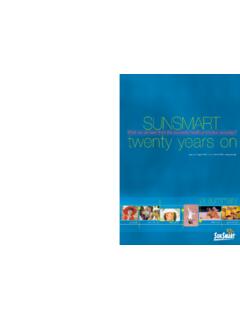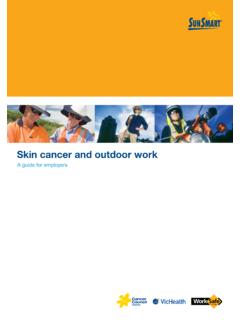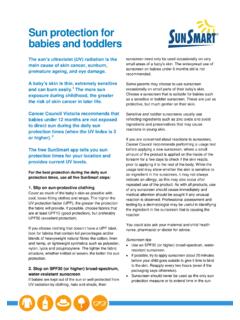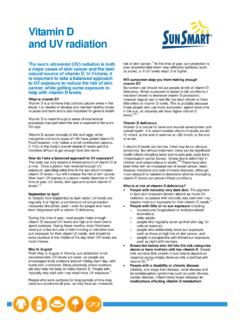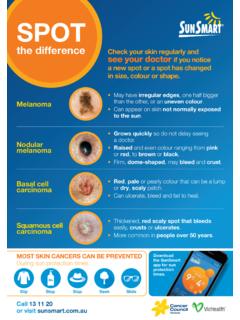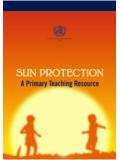Transcription of Sunscreen - SunSmart
1 Sunscreen Cancer Council Victoria recommends using SPF30 or higher broad-spectrum, water-resistant Sunscreen . However Sunscreen alone will not provide adequate protection against overexposure to ultraviolet (UV) radiation. Cancer Council recommends five steps to protect against sun damage during the daily sun protection times (when the UV level is 3 and above): 1. Slip on sun-protective clothing. 2. Slop on SPF30 or higher Sunscreen make sure it is broad-spectrum and water-resistant. Put it on 20 minutes before you go outdoors and re-apply every two hours. 3. Slap on a hat that protects your face, head, neck and ears. 4. Seek shade. 5. Slide on sunglasses make sure they meet Australian Standards. UV levels are most intense during the middle of the day. Check the daily sun protection times, available: on the free SunSmart app online at or in the weather section of newspapers as a free website widget. The sun protection times show when the UV Index is forecast to be 3 or above.
2 What is SPF? Sunscreens with a sun protection factor (SPF) of 4 and above are listed on the Australian Register of the Therapeutic Goods Products can only be listed on the register if they comply with the Australian/New Zealand Standard for Sunscreen products (AS/NZS 2604:2012).2 The highest SPF for Sunscreen available in Australia is SPF50+. The SPF number is only a guide to a Sunscreen s protection. How long a person will take to burn depends on the time of day, time of year, amount of UV reflection, how cloudy it is and their skin type. In laboratory conditions, when used as directed, SPF30 Sunscreen filters of UV radiation and SPF50 filters 98%. Both provide excellent protection if they are applied Applying Sunscreen Apply Sunscreen 20 minutes before you go outside and again every two hours (whether or not the label tells you to do this). Use a generous amount of Sunscreen . The average-sized adult should apply more than half a teaspoon of Sunscreen (about 3 ml) to each arm and the face/neck (including ears), and just over one teaspoon (about 6 ml) to each leg, front of body and back of That is, 35 ml of Sunscreen for one full body application, for an average-sized adult.
3 Many Australians apply too little Sunscreen and forget to re-apply every two hours. This means they usually get less than half the protection stated on the product Sunscreen can be easily wiped off, lost through perspiration and is often applied unevenly in the first place. Putting on more Sunscreen every two hours helps keep you protected. Always reapply after swimming or water sports. The free SunSmart app includes a Sunscreen calculator and a reminder that can be set to sound every two hours reminding you to reapply. What does broad-spectrum mean? There are different types of UV radiation. UVA radiation penetrates deep into the skin, affecting the living skin cells that lie under the skin s surface. UVA causes long-term damage like wrinkles, blotchiness, sagging and roughening, and also contributes to skin cancer. UVB radiation penetrates the top layer of skin and is the main cause of skin damage and skin cancer. Broad-spectrum Sunscreen filters both UVA and UVB radiation.
4 What s in Sunscreen and how does it work? Sunscreens contain ingredients that absorb UV radiation. Examples include octyl methoxycinnamate (OMC) and methylbenzylidene camphor, prime UVB filters; and butyl methoxycinnamate, a prime UVA filter. Sunscreen Some ingredients absorb and reflect UV radiation, such as zinc oxide and titanium dioxide, which are also prime UVA and UVB filters. Is Sunscreen safe to use? There is clear evidence that regular use of sunscreens helps prevent skin cancer. Long-term studies of Sunscreen use in Australia have found no harmful effects of regular ,6 The Therapeutic Goods Administration monitors the scientific literature regarding the safety of specific ingredients of sunscreens. Its conclusions are that there is no evidence that sunscreens containing these ingredients pose any risk to those using There have been questions raised about the safety of sunscreens that contain nanoparticles. The available evidence suggests that nanoparticles used in sunscreens do not pose a risk to Which Sunscreen should I use?
5 Sunscreen can be bought as a cream, lotion, milk or gel. Choose one that best suits your skin type and activity and that you find easy to reapply. If you have sensitive skin and have had a reaction to a Sunscreen , try a fragrance-free product. If you don t want Sunscreen residue to remain on your hands, a gel may work best for you. Not all sunscreens contain the same ingredients. If your skin reacts to one Sunscreen , talk to a chemist or doctor about choosing one with different ingredients. Don t rely on price as an indication of Sunscreen quality. Make sure the Sunscreen you choose is at least SPF30, broad-spectrum and within its use-by date. Sunscreen and babies The Australasian College of Dermatologists states that because very young babies (less than six months of age) absorb more of any chemical applied to the skin than adults, the widespread regular use of chemical sunscreens is not recommended. The American Academy of Pediatrics has stated that sunscreens may be used on infants younger than six months on small areas of skin if adequate clothing and shade are not available.
6 Many brands of Sunscreen have a baby or toddler formula. These are just as protective, but much gentler on their skin. Look for sunscreens that have been dermatologically tested for sensitive skin. How long can you keep Sunscreen ? Check the expiry date and storage conditions on the label. Most sunscreens last about two to three years. They should be stored at a temperature below 30 C. If left in excessive heat ( in the glove box of a hot car or in the sun on the beach), over time, the product may not work as well. Sunscreen use and vitamin D Regular use of Sunscreen when the UV radiation level reaches 3 or above does not greatly decrease vitamin D levels over 11 Sunscreen tested in laboratory conditions does block vitamin D production, however regular use in real life has been shown to have little effect on vitamin D levels. This is because people don t usually use enough Sunscreen , so UV can still reach the skin. Those people who use Sunscreen also tend to spend more time in the sun, so are more likely to have higher vitamin D Further information and resources More information is available at UV-protective clothing and accessories can be purchased at the Cancer Council Victoria s shop or online at References 1 Therapeutic Goods Administration.
7 Australian Regulatory Guidelines for OTC Medicines: Sunscreens. Canberra: Commonwealth Department of Health & Ageing 2003. 2 Standards Australia, Standards New Zealand. Australian/New Zealand Standard AS/NZ 2604:2012. Sunscreen products evaluation and classification. 3 Schalka S, Silva dos Reis VM, Cuc LC. The influence of the amount of Sunscreen applied and its sun protection factor (SPF): Evaluation of two sunscreens including the same ingredients at different concentrations. Photodermatology, Photoimmunology & Photomedicine 2009;25(4):175 80. 4 Schneider J. The teaspoon rule of applying Sunscreen . Archives of Dermatology 2002;138(6):838 9. 5 van der Pols JC, Williams GM, Pandeya N, Logan V, Green AC. Prolonged prevention of squamous cell carcinoma of the skin by regular Sunscreen use. Cancer Epidemiology, Biomarkers & Prevention 2006;15(12):2546 8. 6 Green AC, Williams GM, Logan V, Strutton GM. Reduced melanoma after regular Sunscreen use: randomized trial follow-up. Journal of Clinical Oncology 2011;29(3):257 63.
8 7 Therapeutic Goods Administration. TGA fact sheet: Sunscreens. Commonwealth Department of Health and Ageing 2010. Retrieved from: on 21 June 2012 8 Therapeutic Goods Administration. Literature review on the safety of titanium dioxide and zinc oxide nanoparticles in sunscreens. Commonwealth Department of Health and Ageing: Canberra, Australia 2013. Available from 9 Marks R, Foley PA, Jolley D, Knight KR, Harrison J, Thompson SC. The effect of regular Sunscreen use on vitamin-D levels in an Australian population results of a randomized controlled trial. Archives of Dermatology 1995;131(4):415 21. 10 Farrerons J, Barnadas M, Rodr guez J, Renau A, Yoldi B, L pez-Navidad A, Moragas J. Clinically prescribed Sunscreen (sun protection factor 15) does not decrease serum vitamin D concentration sufficiently either to induce changes in parathyroid function or in metabolic markers. British Journal of Dermatology 1998;139(3):422 7. 11 Norval M, Wulf HC. Does chronic Sunscreen use reduce vitamin D production to insufficient levels?
9 British Journal of Dermatology 2009;161(4):732 6. 12 Jayaratne N, Russell A, van der Pols JC. Sun protection and vitamin D status in an Australian subtropical community. Preventive Medicine 2012;55(2):146 50. This information is based on current available evidence at the time of review. It can be photocopied for distribution. Updated: January 2017


